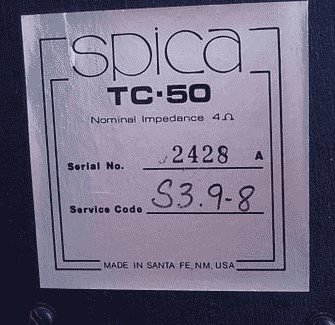Service Codes are at the heart of what made Spica's great.
Except the for SC-50, all Spica's are labeled with a service code. The service code written on the outside of the cabinet and on the back of the woofer. Written in felt-tip, the woofers (tweeters were not) were individually modeled and graded for production and matched for overall sensitivity, frequency, and magnitude of the response peak above the passband and then matched to a corresponding crossover. When you ordered drivers from Spica these codes assured your new driver matched your crossover and your existing driver.
This is a step that most manufactures don't take, but this attention to detail ensured precise imaging from every pair. Every driver was measured using a TDS spectrum analyzer and compared to a reference driver response to determine it's behavior. The resulting code contained three parts describing the overall sensitivity of the woofer and the frequency and magnitude of the response peak above the passband.
The code will appear something like S3.9-8. The letters L, S, and H stand for Low, Standard, High and describe the overall sensitivity of the drivers, important for matching levels. The first number, which ranges from 3.4 to 4.2, is the frequency in KHertz of a response peak in the woofer. According to Bau, the variations come primarily from the inconsistencies in the dustcap - thickness, stiffness, amount of glue used, exact placement on the cone, etc. The last number is the magnitude of the peak in dB above the passband level.
Using the photo below as an example, S3.9-8 has "S" sensitivity driver which is in the statistical middle of production and has 8dB peak at 3.9kHz.

What if the service codes for the woofers don't match?
I don't want to be too crazy here, if your choice is working Spicas versus the dumpster, you should be open to some compromises. Early on I had a problem with my pre-amp. It would occasionally burp DC and fry a woofer. The replacements from Spica were around $80, plus the time and cost to ship. I found a local source for a generic Polydax woofer ($25) and replaced one side with the same model, but a generic non-graded version. While the precise imaging would not have been maintained with this compromise, the crossovers were still time-aligned and would have had similar volume over much of the audio range. Not as good as new, but even without the graded driver they still sounded great.

